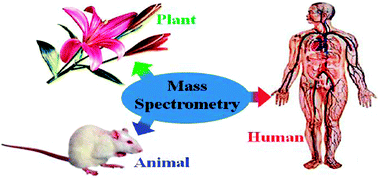In vivo analysis is of paramount importance in monitoring physiological processes that take place in living organisms. Mass spectrometry, an analytical technique with high speed, sensitivity and specificity, is indispensable in biochemical studies nowadays. However, traditional mass spectrometric techniques are of limited applicability in direct analysis of living organisms due to various constraints, e.g., the necessity of ionization of analytes under vacuum and perturbation of physiological functions of living organisms during analysis. Recent development of mass spectrometry, particularly the development of ambient ionization techniques, has opened the door for direct analysis of living organisms. These new mass spectrometric techniques have the features that the ionization processes take place under atmospheric pressure and no or only little sample preparation is required, thus are well suited for analysis of living specimens without significantly perturbing their physiological states. The role of these mass spectrometric techniques in in vivo analysis has been increasingly important in recent years and is expected to be further expanded in the future. In this review, the use of various mass spectrometric techniques in in vivo analysis of biological systems is summarized and the prospects are discussed.

You have access to this article
 Please wait while we load your content...
Something went wrong. Try again?
Please wait while we load your content...
Something went wrong. Try again?


 Please wait while we load your content...
Please wait while we load your content...